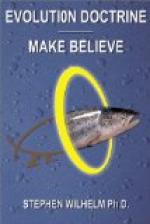The word “palaeontology” means literally the “science of living things of long ago.” It deals directly with the remains of animals and plants found as fossils, and it interprets them through its knowledge of the way modern animals are constructed and of the changes the earth’s crust has undergone. A skull-like object may be found in a coal field and may come into the hands of the palaeontologist: from his acquaintance with the head skeletons of recent types he will be able to assign the extinct creature which possessed the skull to a definite place in the animal scale and to understand its nearer or wider affinities with other animals of later times and of earlier epochs. In doing these things palaeontology employs the methods of comparative anatomy with which we have now become familiar. In the performance of its other tasks, however, palaeontology must work independently. It is necessary to know when a fossilized animal lived, not that its time need be measured by an absolute number of a few thousands or millions of years antedating our own era, for that is impossible. But the important thing is to know its relative age, and whether it preceded or followed other similar animals of its own group or of different divisions. The rocks themselves must be understood, how they have been formed and how they are related in mineralogical nature and in historical succession. Palaeontology also deals with a number of subjects that are not in themselves biological, such as the combination of circumstances necessary for the adequate preservation of fossil relics. In so far as it is concerned with physical matters, as contrasted with strictly biological data, it is one with geology. Indeed, the investigators in these two departments must always work side by side and render mutual assistance to one another in countless ways, for each division needs the results of the other in order to accomplish its own distinct purposes. It must be evident to every one that it is impossible to understand the meaning of fossils and the place of the testimony of the rocks in the doctrine of evolution without knowing much about the geological history of the earth and the influences at work in the past. For these reasons palaeontology differs somewhat from the other divisions of zooelogy where direct observation gives the materials for arrangement and study; in this case the individual data, that is, the fossil fragments themselves, can be made available only through a knowledge of their exact situations, of the reasons for their occurrence in particular places in the rock series and of the way rocks themselves are constructed and worked over by natural agencies. Our task is therefore twofold: certain physical matters of a geological nature must first be investigated before the biological facts can be described.




